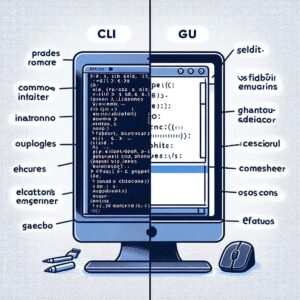A GUI is a user interface that includes graphical elements such as windows, icons, and buttons, allowing users to interact with electronic devices through simple, intuitive actions. Its useful visual cues, make it accessible to users of all levels. A CLI like ‘clip’ is a text-based interface where commands are typed on a keyboard. It opens up a sphere of efficiency and automation that GUIs can struggle to match.
Command line tools have been around since the early days of computing, but ‘clip’ reimagines this familiar interface for contemporary design needs. It dispenses with graphical bells and whistles in favor of a stripped-back, text-based environment where functionality takes center stage.
One of the principal benefits of ‘clip’ is its ability to accelerate the design process. When proficiently mastered, ‘clip’ commands can be executed at a speed that GUI tools are hard-pressed to match. In comparison to navigating through layers of menus and windows, the immediacy with which commands can be scripted, combined, and executed in ‘clip’ provides an almost instantaneous response, a feature immensely valuable in time-sensitive development environments.
With the ability to script commands and automate repetitive tasks, ‘clip’ is perfect for designers who find themselves replicating similar patterns or designs. Through the use of scripts, a complex series of actions can be reduced to a single command, saving precious hours and reducing the scope for human error—a level of automation that GUI-based tools struggle to achieve.
With ‘clip’, designers and developers are prompted to think about their designs in terms of parameters and properties, fostering a logical and structured approach that is beneficial in both personal development and in the pursuit of precise, accurate output.
 Illustrators and developers can fine-tune their designs with pinpoint accuracy through command line parameters. This is particularly important for design considerations that rely on specific dimensions or alignments, which can be explicitly defined in ‘clip’ commands, offering a degree of control often lost in translation with the drag-and-drop nature of GUI tools.
Illustrators and developers can fine-tune their designs with pinpoint accuracy through command line parameters. This is particularly important for design considerations that rely on specific dimensions or alignments, which can be explicitly defined in ‘clip’ commands, offering a degree of control often lost in translation with the drag-and-drop nature of GUI tools.
‘clip’ consumes significantly fewer system resources in comparison to graphics-heavy GUI tools, which means it can run efficiently on older hardware or in environments with limited resources. ‘clip’ can be easily accessed through terminal emulators or command prompts across various operating systems, making it a universally accessible tool for users who may not have access to sophisticated graphical software.
Version control, which is instrumental for team-based projects and maintaining a history of changes, is yet another dimension where ‘clip’ has an advantage over GUI tools. Since ‘clip’ commands are text-based, they can be integrated with version control systems like ‘git’ more seamlessly than their GUI counterparts whose design edits are often difficult to track with precision.
Command line tools can be easily integrated with other software, allowing for a more flexible and cohesive workflow. The command line facilitates collaboration and extends the capabilities of standalone software, an aspect that can sometimes be limited in GUI applications.
For designers with a coding background or developers with a penchant for design, ‘clip’ is an invaluable conductor. The ability to leverage programming knowledge for design allows for innovative solutions that transcend traditional boundaries, enabling a more harmonious and synchronized development process.
Online forums, tutorials, and collaborative projects are rife with enthusiasts eagerly sharing knowledge, tips, and scripts. This world encourages the continuous evolution of the tool.
Users are not confined to the default set of features. They’re empowered to augment and adapt the tool to suit unique needs. With open-source nature at its core, ‘clip’ invites users to contribute and modify its code, pushing the boundaries of what’s possible and tailoring the tool to meet niche requirements.
GUI tools, with their complex interfaces, can be vulnerable to security threats. Minimalistic command line tools like ‘clip’, due to their simplicity and transparency, are easier to secure and less likely to harbor unnoticed security flaws.
Lighter resource usage translates into less energy consumption, which can have a positive environmental impact, especially when scaled across large teams or data centers. clip’ and many CLI tools are free, while the savings in system upgrades and power consumption can be substantial over time.
The Future of CLI Tools in Design
Artificial intelligence (AI) and machine learning (ML) can revolutionize the way designers work by automating complex tasks. CLI tools can act as efficient interfaces to harness the power of these technologies, enabling designers to perform sophisticated operations with simple commands.
The concept of headless design, where the design processing is done without a GUI, may become more prevalent. Designers could leverage CLI tools to generate and manipulate designs programmatically, offering enhanced possibilities for batch processing and mass customization. This could be critical for industries like web development, where the capacity to produce variations of design elements at scale can save both time and resources.
CLI tools are compatible with cloud environments since they do not rely on graphical rendering. Designers could use CLI tools to work collaboratively on projects stored on remote servers, streamlining workflows and reducing the dependency on local computing resources.
Advancements in the ease of use of CLI tools will continue to make them accessible to a broader audience. Better documentation, more intuitive command syntax, and comprehensive learning resources can lower the barrier to entry, enabling more designers to adopt CLI tools in their work.
‘clip’, with its multitude of benefits from speed to precision, and from automation to extensibility, has proved that it can succeed alongside GUIs. While GUIs will continue to hold their own, particularly for users valuing visual feedback and user-friendly interfaces, the niche carved out by ‘clip’ and command line tools will remain both relevant and revolutionary.